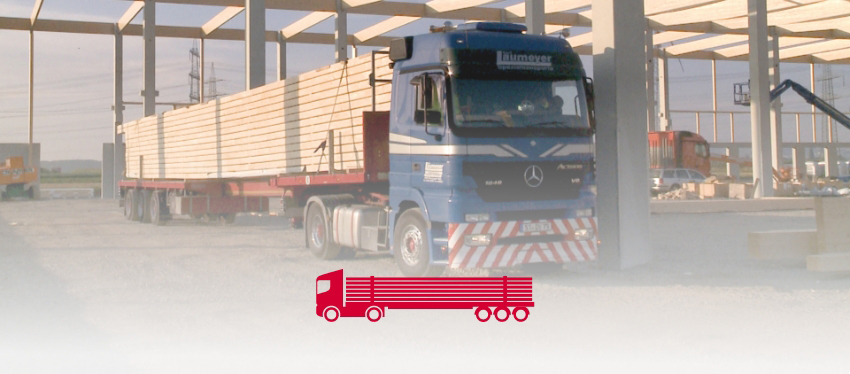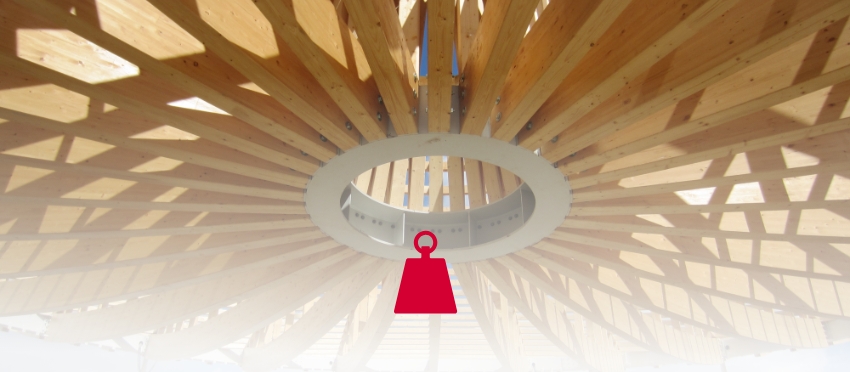Taking responsibility – building with wood
Sustainability
build with wood
Wood is the building material of the future. Thanks to its excellent material properties and ecological advantages, it is becoming increasingly popular. The important principle of keeping the protection of our environment in mind in all areas of life is optimally implemented in the building sector through the use of wood as a building material. Building with wood and living or working in buildings made of wood is a question of ecological responsibility and common sense – both for us as manufacturers and for all users.
CO2 advantages
of wood as a building material
Life cycle assessment – wood as a CO2 reservoir
Trees extract carbon dioxide from the air, store the carbon in the wood and produce oxygen. The CO2 remains bound in the wood, which relieves the atmosphere throughout the entire life cycle of the wood.
In the case of final thermal utilisation, the wood only releases the same amount of CO2 that it had previously absorbed and bound. Due to this closed cycle of CO2 absorption and CO2emission, wood as a building material achieves the best eco-balance in the life cycle assessment.
So our goal should be to create huge carbon stores by constructing our buildings out of wood and thus prevent the CO2 from doing damage to the atmosphere. In addition, we should maximise the lifespan of all wooden building components in order to use the positive effect of CO2 storage for the protection of the atmosphere for as long as possible.
For this reason, our wooden components can be reused several times.
Energy saving – wood as a plus energy product
More energy can be generated from the residues of wood products than is needed for their production. Therefore, wood products are plus-energy products – we can produce them, use them and still have a surplus of energy. In addition, wood generates the lowest energy costs in production, transport and processing compared to all other building materials. Due to their low dead weight and high strength, timber buildings also consume less energy than buildings made of other materials, from the production of the components to their transport and assembly.
Conserving resources – the only building material that grows back
Wood is an inexhaustibly renewable, natural raw material with excellent reuse possibilities. 90% of the wood used in Europe comes from European forests, whose stock is increasing every year due to sustainable forestry and forest management. We attach great importance to the responsible use of wood as a raw material, which is why we are PEFC-certified and only use wood from sustainable forestry, i.e. for every tree that is felled, a new one is planted. In this way, we actively counteract the emergence of deforested areas. Our raw material comes almost exclusively from Europe. This also allows us to keep transport distances short and thus avoid CO2 emissions.
Timber structures can be reused for new building projects. In addition, there are a multitude of other possibilities in cascade use for reuse as raw material or in the field of energy generation. Therefore, buildings made of wood are always also a source of raw materials. In a world with finite resources, sustainability in construction and a responsible choice of materials is becoming increasingly important and popular.
Weight and transport – High load capacity, low dead weight
Compared to other materials, wood is an extremely lightweight building material with a high load-bearing capacity, and its low weight means that it causes only a fraction of the transport costs and emissions. This results in immediate ecological and economic benefits. In direct comparison with wood, concrete is five times heavier with the same load-bearing capacity and causes five times higher transport costs.
Carbon Footprint
Compared to other building materials, wood requires the least amount of energy to produce. Wood therefore has the smallest CO2 footprint and is therefore by far the most environmentally friendly building material.
Healthy living
DERIX cradle to cradle
Circularity
What does
circularity mean?
Linear economy
Circular economy
What does circularity mean
in the construction industry?
Circular construction continuously strives to repurpose and reuse buildings and building materials. A new building should therefore be constructed largely from recyclable materials and be easily deconstructable. For example, constructions can be dismantled at the end of their use and reused in another building. This minimises the energy end-use and significantly extends the life cycle of the buildings and materials. For wood as a building material, this means that: CO2 remains bound for longer. Furthermore, wood as a building material offers flexible construction and utilisation concepts such as modular timber construction systems. These systems allow flexible expansions and downsizing as well as uncomplicated dismantling or even rebuilding at a new location. The DERIX-Group was the first company in the industry to commit to a general take-back of its components and is thus considered a pioneer in circular construction.
DERIX take-back obligation for
glulam and X-LAM elements
Where’s our
wood from?
Weight advantage comparison
solid wood and concrete
Special transports
with overlength
For the same number of concrete girders, 12 trucks have to be moved.


12 Wooden beams
Weight & Transport
In direct comparison with wood, concrete is five times heavier with the same load-bearing capacity and causes five times higher transport costs.

Concrete support

Wooden beam